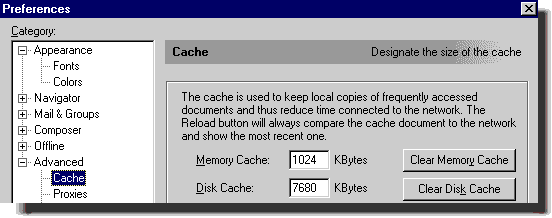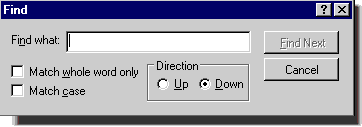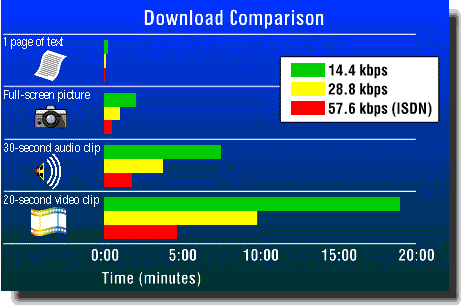Despite the promise of high-speed broadband service, most people still access the Web with a modem. Waiting for web pages to download can be frustrating, as is trying to find targeted information in a sea of data. To make Web surfing a more satisfying and productive experience, we offer ten tips:
 View sites in text-only mode.
View sites in text-only mode.

Sure, web designers spend a great amount of time creating wonderful graphics, but it can take quite a while to download large graphic files. To speed things up, turn off the images in your web browser.
With Internet Explorer 5.0, under the Tools menu, select Internet Options, then click the Advanced tab. Now uncheck Show Pictures.
Thoughtful designers will include something called an ALT tag, which is a written description of the image. If you want to see a particular image, click on the tag with your right mouse button and select View Image. For Mac users, just hold down the mouse button over the graphic. You can also click the Image button in Navigator to load all the images.
 Use the Stop button.
Use the Stop button.
When you access a website, what you are actually doing is downloading a set of digital files. You can see how the download is progressing if you look at the status bar located in the lower left-hand corner of your web browser. If you get tired of waiting, click the Stop button to view the files that have already been downloaded. Then you can decide if you want to continue. If you do, click the Reload or Refresh button.

 Increase your cache.
Increase your cache.
Files you download are stored in a cache (pronounced
like "cash") on your hard drive. That way when you return to a site, you
don't have to download the files again from the server, just access
them locally from your cache. After a while though, the cache becomes full.
Your web browser automatically deletes old files as you continue to surf
the Web. But if you visit many of the same sites regularly, you can speed
up access by caching more of them. To do this, increase the size of your
cache. 10 Mb is optimal.
If you use Netscape Navigator 4.0 or a later release, under the Edit menu, choose Preferences, then click on Advanced. Now click on Cache. In the appropriate box, increase the cache size.

With Explorer 5.0, under the Tools menu, select Internet Options. Next, on the General tab, click on Settings. Use the slider to increase the cache.
 Save keystrokes by using Bookmarks or Favorites.
Save keystrokes by using Bookmarks or Favorites.
Web addresses or URLs can be unwieldy. Worse, if you type them wrong, you get an error message. To avoid these problems, save the addresses of sites you want to revisit. For details on how to do this, read the Bookmarks and Favorites article.
 Use the Find feature of your web browser.
Use the Find feature of your web browser.
 Once you've downloaded a document, the Find feature quickly
locates a particular term in which you are interested. Why take the time
to scroll through the entire document?
Once you've downloaded a document, the Find feature quickly
locates a particular term in which you are interested. Why take the time
to scroll through the entire document?
 Pick two search engines and learn how they
work.
Pick two search engines and learn how they
work.
The difficulty of finding specific information is by far the biggest complaint we hear. Although dozens of search engines are available, pick two, then take the time to learn them well. For more on searching read Searching the Web. In case you're interested, our current favorites are Yahoo!, AltaVista and Google.
 Choose your own home page.
Choose your own home page.
Both Netscape and Microsoft set their sites as the default home page when you launch your web browser. If you want to begin your surfing by reading a daily newspaper or better yet, Learn the Net, why not start there first? Here's how to select a new home page.
 Open a new window.
Open a new window.

While you are downloading one web page, you can access another site by opening a second browser window. With Navigator, go to the File menu and choose New, then Navigator Window. With Internet Explorer, select New, then Window from the File menu. A word of caution: Although you can open multiple windows, this will slow down your computer, so don't go overboard. Remember to close the additional windows to free up disk space.
 Surf during off-peak hours.
Surf during off-peak hours.
Most commuters experience rush hour, when highways bog down with traffic. The same phenomenon happens on the Internet, usually in the late afternoon and early evening, when people log on to check e-mail, chat and play games. If you want to avoid the slowdown, go online in the morning or late at night, when traffic is lighter.
 Get a faster connection.
Get a faster connection.
If you are still using a 28.8 Kbps modem, it's time to upgrade. Most people these days access the Web at twice that speed. New modems offer access at 56 Kbps. Before you upgrade, however, make sure your Internet service provider supports 56 Kbps modems. Better yet, consider getting a high-speed service such as DSL or cable modem. It may cost a bit more, but it will greatly improve your satisfaction.
